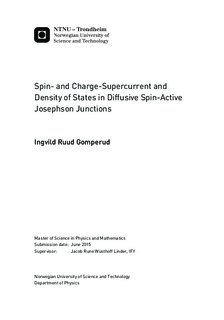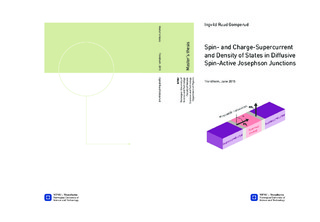| dc.description.abstract | In this thesis we investigate theoretically the properties of spin-active Josephson junctions, using a normal metal as the weak link. The system is examined both analytically in the weak proximity effect regime and numerically in the full proximity effect regime. We consider the diffusive limit, and use the quasiclassical Usadel equation to find the Green function representation of the system. We assume that all materials are in equilibrium, i.e. in the absence of applied voltages and temperature gradients, and show that a conserved long-ranged spin-supercurrent flows through the normal metal, driven by both magnetic misalignment and the difference in phase between the two superconductors.
Another result from this thesis is that we find the 0-pi transition to be accessible not only through the superconducting phase difference $\theta$, but also by varying the magnetic displacement angle alpha between the magnetizations of the spin-active interfaces. Moreover, we show analytically that the spin-supercurrent has a term which is independent of the superconducting phase difference, and that the remaining term goes like cos(theta), in contrast to sin(theta) which is found for the charge-supercurrent. The charge-supercurrent can be split into one singlet and one triplet term, where both has an s-wave symmetry and where the triplet term is odd in frequency.
The numerical solutions consider both the situations in absence and in presence of isotropic spin-flipping on magnetic impurities and isotropic spin-orbit coupling. We find that the spin-flip scattering weakens the overall superconductivity, and that the spin-flip strength has monotonic behavior on the supercurrents. Interestingly, we find different behavior for the spin-orbit coupling. Here it seems like the triplet correlations are converted back into singlets, which can be understood by the averaging over spin due to the isotropic form of the spin-orbit coupling. At last, we briefly discuss how the inverse proximity affects the superconducting correlations. | |

